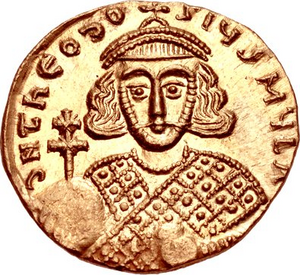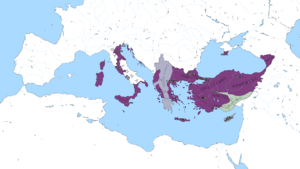ثيودوسيوس الثالث
| ||||||||||||||||
| ||||||||||||||||
ثيودوسيوس الثالث (باليونانية: Θεοδόσιος Γ). كان الإمبراطور البيزنطي من 715 إلى 25 مارس 717. Before rising to power and seizing the throne of the Byzantine Empire, he was a tax collector in Adramyttium. In 715, the Byzantine navy and the troops of the Opsician Theme (Byzantine province) revolted against Byzantine Emperor Anastasios II (ح. 713–715), acclaiming the reluctant Theodosius as Emperor Theodosius III. Theodosius led his troops to Chrysopolis and then Constantinople, the capital, seizing the city in November 715. Anastasios did not surrender until several months later, accepting exile into the monastery in return for safety. Many themes refused to recognize the legitimacy of Theodosius, believing him to be a puppet of the troops of the Opsician Theme, especially the Anatolics and the Armeniacs under their respective strategoi (generals) Leo the Isaurian and Artabasdos.
Leo declared himself emperor in the summer of 716 and allied himself with the Umayyad Caliphate, an Islamic empire; Theodosius allied himself with the Bulgarians under Khan Tervel (ح. 700–721), setting a firm border at Thrace, ceding the Zagoria region to the Bulgarians, as well as stipulating tribute payment to the Bulgarians. Leo then marched his troops to Constantinople, seizing the city of Nicomedia, capturing many officials, including Theodosius's son. With his son in captivity, Theodosius took the advice of Patriarch Germanus and the Byzantine Senate, and negotiated with Leo in spring 717, agreeing to abdicate and recognize Leo as emperor. Leo entered Constantinople and definitively seized power on 25 March 717, allowing Theodosius and his son to retire to a monastery as monks. Theodosius became bishop of Ephesus, and died at some point after, possibly on 24 July 754.
. . . . . . . . . . . . . . . . . . . . . . . . . . . . . . . . . . . . . . . . . . . . . . . . . . . . . . . . . . . . . . . . . . . . . . . . . . . . . . . . . . . . . . . . . . . . . . . . . . . . . . . . . . . . . . . . . . . . . . . . . . . . . . . . . . . . . . . . . . . . . . . . . . . . . . . . . . . . . . . . . . . . . . . .
التاريخ
خلفية
After the Umayyad Caliphate was repelled in the first Arab siege of Constantinople (674–678), the Arabs and Byzantines experienced a time of peace.[1] However, hostilities were resumed by Byzantine Emperor Justinian II (ح. 685–695, 705–711), resulting in a string of Arab victories. As a consequesence, the Byzantines lost control over Armenia and the Caucasian principalities, and the Arabs gradually encroached upon the Byzantine borderlands. Annually, generals from the Caliphate would launch raids into Byzantine territory, seizing fortresses and towns.[2][3][4] After 712, the defenses of the Byzantine Empire began to weaken, Arab raids began to penetrate deeper into Byzantine Asia Minor, and Byzantine response to these raids became less common.[5][6] The success of these raids emboldened the Arabs, who prepared for a second assault against Constantinople as early as the reign of Caliph al-Walid I (ح. 705–715). After his death, his successor, سليمان (ح. 715–717) continued planning the campaign,[7][8][9] Sulayman began assembling his forces in the plain of Dabiq, north of Aleppo, entrusting the command of these forces to his brother, Maslama ibn Abd al-Malik.[10]
The Slavs and Bulgars also formed a growing threat to the northern frontier of the Byzantine Empire, threatening Byzantine control in the Balkans.[11] During the rule of Byzantine Emperor Philippikos Bardanes (ح. 711–713), in 712, the Bulgarians under Khan Tervel advanced as far as the walls of Constantinople itself, plundering the surrounding country, including villas and estates near the capital, where the Byzantine elites often summered.[12]
Theodosius came to power during a period called the Twenty Years' Anarchy, defined by struggles between the emperors and the elites, and political instability, with a rapid succession of emperors. The nobles of this time were often natives of Asia Minor, and rarely had a strong agenda beyond preventing the emperors from growing stronger and disrupting the status quo.[13][14] The Twenty Years' Anarchy began when Emperor Justinian II was overthrown by Leontios (ح. 695–698) in 695, ending the Heraclian Dynasty, which had ruled for eighty years. During this, seven different emperors took the throne, including a restored Justinian for a time.[14] The modern historian Romilly Jenkins states that between 695 and 717, the only competent emperors were Tiberius III (ح. 698–705) and Anastasios II (ح. 713–715).[14] The crisis was ended by Emperor Leo III (ح. 717–745), who overthrew Theodosius, and whose dynasty reigned for 85 years.[15]
حكمه
كان ثيودوسيوس ضابط المالي و جابيا للضرائب في الجزء الجنوبي من ثيمة اوبسيكيون, يقال انه ابن الامبراطور السابق تبيريوس الثالث .عندما قامت قوات ثيمة اوبسيكيون بثورة ضد الإمبراطور أناستاسيوس الثاني ، اختاروا ثيودوسيوس الثالث كإمبراطور. .و بعد حصارهم القسطنطينية لمدة ستة أشهر، نجحوا بأخذ القسطنطينية بقيادة ثيودوسيوس الذي عين امبراطورا. مما اجبر هذا الامبراطور المخلوع أناستاسيوس للفرار الى نيقية، وكان مضطرا في نهاية المطاف أن يعترف بالامبراطور الجديد في 716م وتقاعد الى الدير في تسالونيكي.
ولا يعرف سوى القليل من ثيودوسيوس في عهد حكمه القصير. فواجه على الفور الغزو العربي في عمق الأناضول وتقدم الأسطول العربي. في 716 خلص معاهدة مع ترفل البلغاري مواتية للبلغار في محاولة لتأمين الدعم ضد الغزو العربي. دفعت هذه السياسة ثمارها في سنة 719م عندما ساعد في تخفيف الحصار العربي الثاني للقسطنطينية.
خلعه من الحكم
في سنة 717 ، حاكم مقاطعة الأناضول، ليو الايسواري ( ليو الثالث)، تمرد ضد حكم ثيودوسيوس بالتواطؤ مع الجنرال أرتاباسدوس، حاكم مقاطعة أرمينيا. و تم القبض على نجل ثيودوسيوس من قبل ليو في نيقوميديا، واختار ثيودوسيوس الاستقالة من العرش في 25 مارس 717. هو وابنه اصبحا في وقت لاحق رجال الدين.
مواضيع مرتبطة
مراجع
- قاموس أكسفورد لبيزنطة، مطبعة جامعة أكسفورد، 1991
| سبقه أنستاسيوس |
الامبراطور البيزنطي 715–717 |
تبعه ليو الثالث |
- ^ Lilie 1976, pp. 81–82, 97–106.
- ^ Blankinship 1994, p. 31.
- ^ Haldon 1990, p. 72.
- ^ Lilie 1976, pp. 107–120.
- ^ Haldon 1990, p. 80.
- ^ Lilie 1976, pp. 120–122, 139–140.
- ^ Guilland 1955, p. 110.
- ^ Lilie 1976, p. 122.
- ^ Treadgold 1997, p. 344.
- ^ Guilland 1955, pp. 110–111.
- ^ Vasiliev 1980, p. 229.
- ^ Ostrogorsky 1957, p. 136.
- ^ Bury 1889, pp. 384–385.
- ^ أ ب ت Jenkins 1987, p. 60.
- ^ Jenkins 1987, p. 63.


